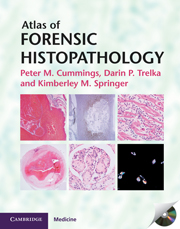6 - Injuries
Published online by Cambridge University Press: 05 August 2013
Summary
INTRODUCTION
There are numerous issues associated with the interpretation of injuries. If the postmortem interval is short, misleading artifacts such as decomposition should not confuse the pathologist. If the individual survives long enough to be taken to the hospital there are likely to be myriad therapy-related artifacts with protean morphologies. In addition, rough handling of the body during conveyance from the scene to the office or morgue may introduce postmortem contusions, abrasions, lacerations, or even fractures. Changes in tissues caused by environmental conditions can also be confused with natural disease processes or even injuries. This is why going to the scene, or at least viewing the photographs and observing how the body interacted with the environment, can be crucial to one’s interpretation of marks on a body. The discovery of soot in the airway can establish that the individual was alive and breathing at the time of a fire. Histologic sampling of a gunshot wound can determine whether a defect is likely to be an entrance or an exit wound. In this chapter there are a number of photographs that will demonstrate the typical histologic changes associated with gunshot wounds, fire, hypothermia, and electrocution.
- Type
- Chapter
- Information
- Atlas of Forensic Histopathology , pp. 80 - 91Publisher: Cambridge University PressPrint publication year: 2000



